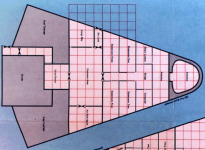I'm adjusting the access way (the part across the top) and making minor adjustments.
The crew can access the "tube" (1.5m wide by 1.2m high) to move between the engineering section and the control compartment but it is a tight hand over hand trip because the space includes the lowering hoists for the module.
The crew can access the "tube" (1.5m wide by 1.2m high) to move between the engineering section and the control compartment but it is a tight hand over hand trip because the space includes the lowering hoists for the module.


